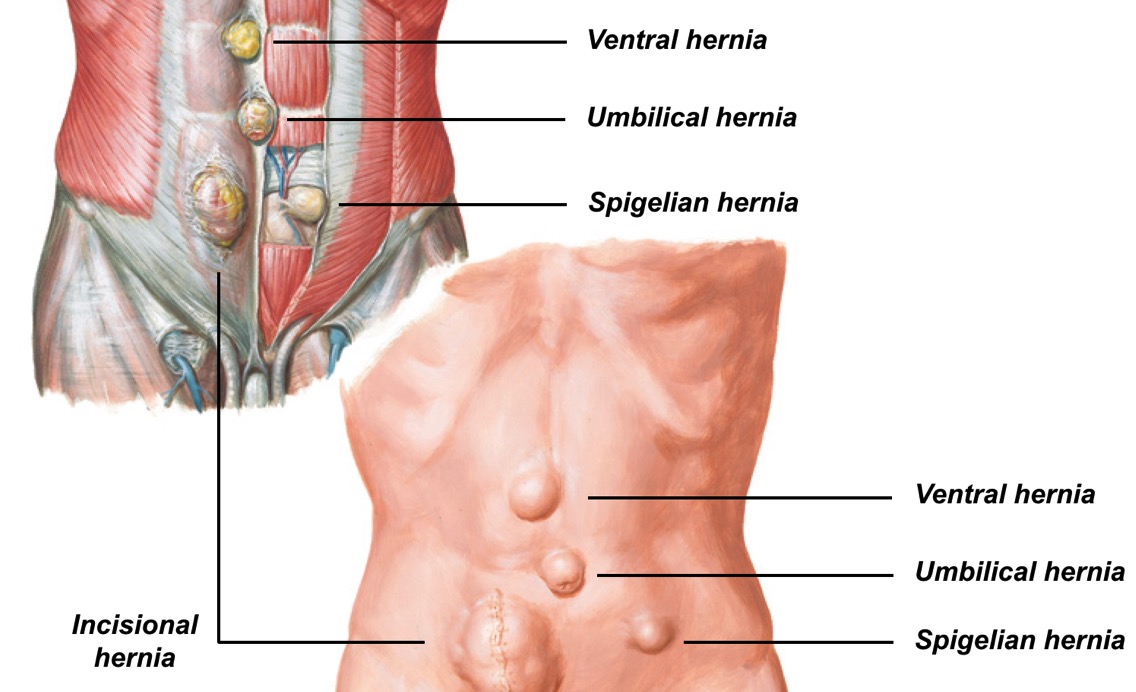An abdominal hernia is the exit of abdominal structures through the naturally weaker abdominal muscles. It occurs more often in men and boys than in women.
Increased pressure in the abdomen during heavy lifting, persistant cough or straining during defecation can cause weakened muscles to part and tissue to bulge through. The tissue can be fat or a section of the intestine. It appears as a swelling in various sections of the abdomen, most often in the groin or as swelling in the testicular area. Hernias do not always cause pain. They normally disappear if the patient lies down.
Hernia types
Hernias can be classified into several types depending on location. Depending on the age of the patient, hernias occur most often in the groin area, at the entry into the inguinal canal between the stomach and groin. A hernia may occur on both sides at once and is twelve times more common in men than women. A hernia may also appear in the abdomen, the thigh or genitalia. There are several types of hernias: a post operative hernia occurs on the site of a past operation, an umbilical hernia occurs at the bellybutton, an indirect inguinal hernia occurs on the inner side of the groin.

Indirect and direct inguinal hernias can be returned through the inguinal calan into the abdomen with a gentle push. Hernias carry the risk of the bulging tissue, e.g. intestine, becoming trapped inside the hernia (incarcerated hernia), cutting off its blood supply (strangulated hernia). A part of the intestine may die, requiring more complex and dangerous surgery. Hernias normally expand with time, so a surgical intervention is required. The goal of a surgical procedure is to strengthen the abdominal wall and reduce the likelihood of the hernia occurring again.
Symptoms of inguinal hernia
The main symptom of inguinal hernia is a swelling on one or both sides of the groin which occurs suddenly or grows over time and disappears if the patient lies down. In men they can appear as swelling in the scrotum. Symptoms include discomfort or sharp pain during physical efforts, lifting or sports exercise which abates when stationary. A feeling of tightness may appear in the groin area and a burning sensation in the swelling. Additional symptoms occur if the hernia becomes incarcerated.
Symptoms of inguinal hernia: swelling becomes hard, red, pain occurs along with increased temperature and heart rate. If treatment is not forthcoming, further symptoms include nausea, vomiting and infection. A surgical intervention is required as soon as possible.
Surgical procedure
There are two methods for surgical treatment of hernias. Open treatment - an incision is made in the skin at the location of the hernia. Laparoscopic treatment - surgical treatment using small incisions and an endoscope. Recovery after a laparoscopic procedure is much faster. Open surgeries are performed in local, epidural, spinal or general anesthesia while endoscopic procedures are only performed in general anesthesia. During the open procedure a surgeon performs an incision in the area of the hernia, pushes the intestine and peritoneum back into the abdomen. He then reinforces the muscle wall with stitches and, if required, uses a synthetic net as additional reinforcement. During the laparoscopic procedure the surgeon fills the abdomen with a special gas. He then makes several small incisions and introduces the endoscope and instruments to the location of the hernia. The intestine and peritoneum are pushed back into the abdomen and the tear in the abdominal wall is closed with a synthetic net (hernioplasty).
Risk and complications
The procedure is very safe. However, there are possible complications that should be known and recognised in a timely manner. Complications may arise due to the anesthesia or the surgical procedure itself. Risks of general anesthesia include nausea, vomiting, retention of urine, damage to the oral cavity and teeth, throat pain and headache. More severe complications include heart attack, brain stroke and pneumonia. There are also some complications that may arise after any surgical procedure.
Possible complications: infections, bleeding and scars.
Injuries to these structures may lead to permanent damage and subsequent additional operations. Hernias may reoccur years after successful surgical treatment. Possibilities of recurrence are reduced with hernioplasty.
After surgery
Most patients can leave the hospital on the day of procedure or just a day later. Some swelling in the incision area and a small haematoma that may spread to the penis is normal after inguinal hernia surgery. In case of severe pain, large haematoma or inability to urinate a doctor should be notified. Lifting of heavy burdens, bending and bowing is not allowed for a few weeks after the procedure. Proper rest reduces the chance of the hernia reoccurring. The physician shall consider the course of recovery and the patient’s state of health and advise when to return to work and what loads to handle. The patient must call the physician in case of increased temperature, abdominal pains, weakening, swelling of the surgical wound or infection.
Prevention
The occurrence of gallstones cannot be wholly prevented. If gallstones do occur, an appropriate diet may prevent their formation, worsening and recurrence of symptoms. Persons with gallstones who are not experiencing symptoms should avoid fatty and fried foods and foods that are hard to digest. During a gallstone attack patients should eat a fat free diet. This includes eggs which contain large amounts of cholesterol and promote gallbladder contractions. No special diet is required after gallstone surgery, but patients tend to have more difficulty with fatty foods.